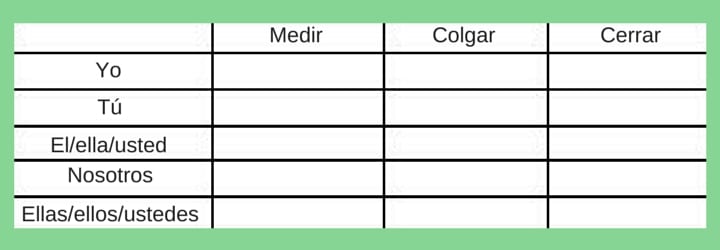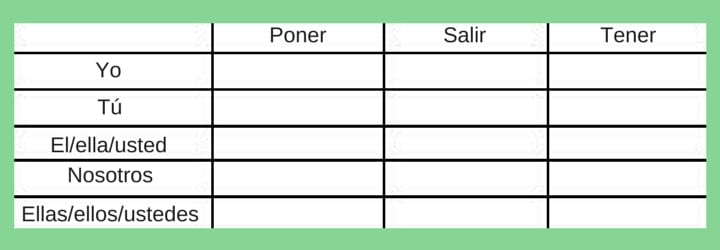Struggling with Spanish grammar? As you’re learning how to conjugate verbs in Spanish, you’ll need to watch out for stem-changers! Here’s an overview from Fairfax, CA tutor Jason N...
If you’re reading this now, it probably means you are well-aware of the importance of conjugation to use verbs to describe situations and events. And as you’re learning a new language, like Spanish, this is essential to your progress!
Conjugations enable us to form coherent sentences that specify the ‘who’ and ‘what’ of a particular action. This article is part II of a series of blog posts where I’ll explain how to conjugate Spanish verbs — so if you haven’t read that first one yet, do so now.
If you have already read the first article, great! Now that you know about to conjugate basic verbs in present tense, next I’ll show you how to take your conjugation skills to the next level. This involves learning stem-changing verbs Spanish.
In all three conjugations of verbs (with –ar, –er, or –ir endings) there are some verbs whose vowels change within the stem. Let’s go through some key vocabulary first.
- The word ‘infinitive‘ refers to the verb before it’s conjugated.
- The ‘stem‘ of a verb usually refers to the first syllable of the verb in its infinitive form.
- Consequently, a ‘stem-changing verb‘ is when the stem changes from its infinitive to its conjugated form.
The beginning three steps are the same as with the normal verbs:
To understand stem-changer conjugations, we want to focus here on the stem’s vowel. These stem-changes occur in all of the five conjugation variants except nosotros or ‘we’ form (and vosotros if you’re in Spain), which both maintain their regular stem.
Spanish Stem Changing Verbs
There are six types of stem-changes in Spanish:
e → i
o → ue
e → ie
i → ie
u → ue*
o → hue
*Note: We only implement the stem-change (u → ue) in the verb jugar (to play) as most verbs with a ‘u’ in their stem aren’t stem-changers.
How to Conjugate e → i Stem-Changers in Spanish
Let’s go through the most common three. In this example, the stem of the verb pedir (to ask for) is ped-. The key vowel here is the ‘e.’ The ‘e’ changes to an ‘i’ when it’s conjugated in the present tense, except for in its nosotros form.
Pedir (e → i)
Yo Pido
Tú Pides
Él/ella/usted Pide
Nosotros Pedimos
Ellos/ellas/ustedes Piden
As you can see, the ‘e’ in the stem ped- changes to an ‘i’ in all the five person variants besides nosotros. Not too difficult, right?
How to Conjugate o → ue Stem-Changers in Spanish
Let’s try another common one. Just like the ‘e’ in pedir changes to an ‘i,’ the ‘o’ in poder, from the stem pod- changes to ‘ue,’ except, as always, in its nosotros form.
Poder (o → ue)
Puedo
Puedes
Puede
Podemos
Pueden
How to Conjugate e → ie Stem-Changers in Spanish
Another frequent stem-changer is the ‘i’ to ‘ie.’ Let’s take, for example, querer:
Querer (e → ie)
Quiero
Quieres
Quiere
Queremos
Quieren
Let’s practice with the following verbs:
Medir (e → i) To measure
Colgar (o → ue) To hang up
Cerrar (e → ie) To close
Aside from Spanish stem-changing verbs, many present-tense verbs have an irregular conjugation in their Yo form, in that it doesn’t follow basic tendency to end in ‘o’ at the end of the word after removing the ending (-ar, –ir or –er), and instead ends in –go.
For example, hacer (to do or to make) in its Yo present form: o → go
Instead of conjugating hacer in its Yo form as “haco,” we say, “hago” to mean, “I do or make.” This is the same with venir and seguir.
Spanish Verb Conjugation Practice — Stem-Changers
Now, practice with the following verbs in their ‘yo’ form:
Not sure if you’ve quite got it? A Spanish tutor can help you master Spanish stem changes. Stay tuned for Part III when I show you about to conjugate verbs in their past tense.
 Post Author: Jason N.
Post Author: Jason N.Jason N. tutors in English and Spanish in Fairfax, CA. He majored in Spanish at UC Davis, lived in Mexico for 3 years where he completed a Master’s degree in Counseling, and studied Spanish Literature and Psychology at the University of Costa Rica. Learn more about Jason here!
Photo by Matt-Richards
Suzy S.





